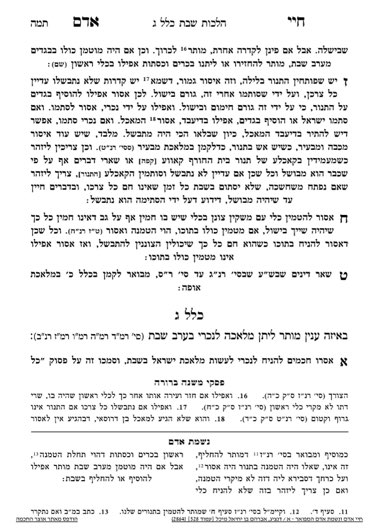We have finished Klal 2. The Chayei Adam discusses hatmana again in Klal 20, but we address a few more points here.
We learned that we follow the approach of the Rema (shiur S0049) that hatmana b’miktzas is muttar. We left off (shiur S0056) with a question regarding whether hatmana b’miktzas is defined by the container or by the food itself. Do we look at the container, and as long as some of the container is not insulated it is not considered hatmana, or do we look at the food, and if all of the food is insulated it is considered hatmana, even if there is empty space in the container.
Certainly, exposing a very small amount is not sufficient, but the question applies when a significant amount is not insulated. For example, if one has a heating urn with an insulating jacket around it, would it be sufficient to roll up some of the insulating jacket, even if that part of the urn does not have liquid in it, or would one need to be sure that the jacket is rolled up around the food itself. Similarly, if one wishes to warm up a bottle of baby milk for a baby, if they submerge the bottle completely, they are clearly performing hatmana according to all opinions. Since the bottle is buoyant, if they let the bottle naturally sit in the water, part of the bottle will protrude above the water, so again we come to our question.
Rav Moshe Feinstein, in a series of teshuvos on the topic of hatmana, held that this scenario is a problem. Even though the container is not totally insulated, he held that we look at the food. Since the food is fully submerged, it is considered hatmana.
Other poskim disagree with Rav Moshe. They hold that Chazal discuss the concept of hatmana in the context of the container which is holding the food, rather than the food itself, because the container is where a person is performing the hatmana, and not on the food. If we look at hatmana based on the food, we should argue that the pot itself is hatmana on the food. Chazal clearly did not look at hatmana in this manner, so as long as the container protrudes above the insulation, it is sufficient. Many poskim follow this opinion, and one may rely on it.
There is a concept of cooking something sous vide, where meat is vacuum packed and cooked at a low temperature in hot water for a long time. The water functions as a mosif hevel, so it would be hatmana to leave meat in the water even from before Shabbos
We discussed a case (S0048) in which one performs hatmana for the purpose of protecting the food itself rather than for the purpose of adding heat. Rav Moshe uses this point to explain why there is no issue of hatmana with the pot in which the food is cooking. He explains that the purpose of the pot is to hold the food, keep the liquid in, avoid other items from falling in, and so on, so it does not create an issue with hatmana.
Summary
- We define hatmana b’miktzas based on the container rather than the food. Therefore, if a part of the container is not insulated, even if that part of the container is empty, it avoids the issue of hatmana.
- Sous vide cooking is an example of hatmana in water, where the water functions as a mosif hevel.



